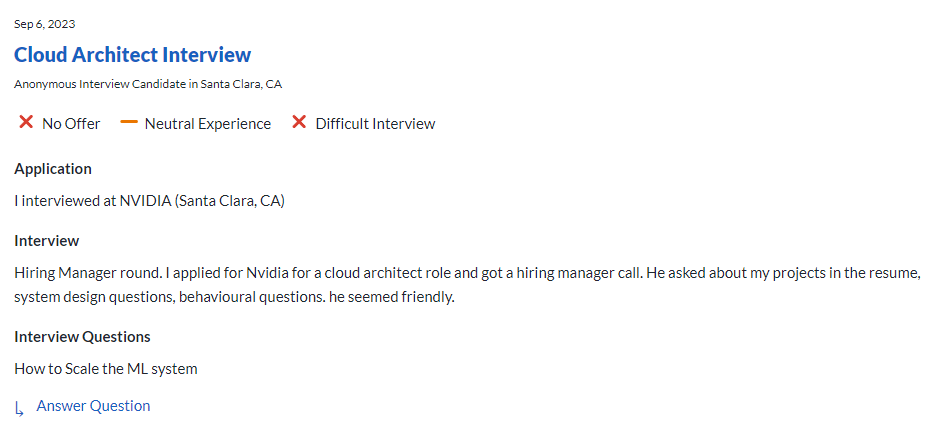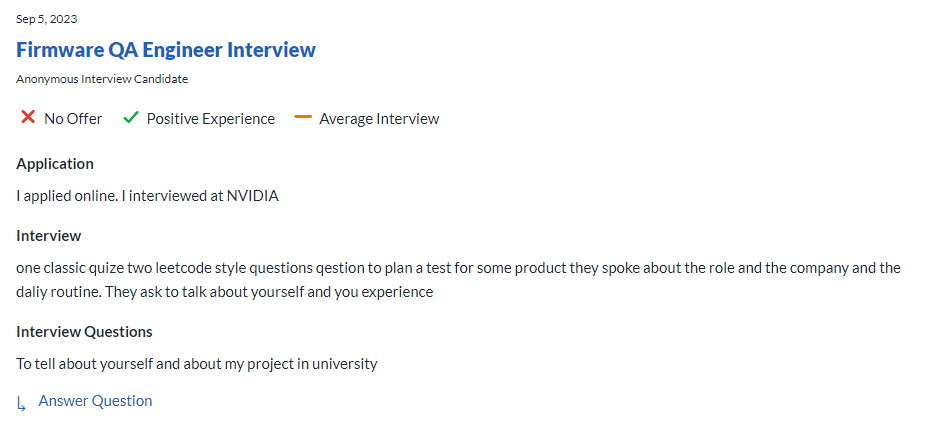NVIDIA Interview Process - An Expert Guide
Explore our expert guide to the NVIDIA interview process, offering essential tips and insights to help you succeed.

With a community of over 4 million developers creating thousands of applications for accelerated computing, and more than 40,000 companies embracing NVIDIA's AI technologies, the impact of this tech giant is felt far and wide.
If you're ready to unlock your potential and explore a career at NVIDIA, get ready for a journey where the possibilities are limitless. Today at 4 Day Week , we'll explore the NVIDIA interview process in more detail to assist you in securing your dream job.
So, let’s get started!
What Do Interviewees Say About the NVIDIA Interview Process?
Overall, applicants view NVIDIA as positive.

On Glassdoor, 60% of interviewees rate their experience as “positive,” 18% as “negative,” and 23% as “neutral.” The applicants rate the difficulty 3.2/5.0, meaning NVIDIA’s interviews are slightly more challenging than similar companies'.
Here’s a selection of reviews for deeper insights:
- “A telephone interview in which I told about myself and the experience I have, followed by an hour-long face-to-face interview in which they asked questions about code and knowledge of technologies in which I have experience and which are relevant to the position for which I was tested.”

- “Hiring Manager round. I applied for Nvidia for a cloud architect role and got a hiring manager call. He asked about my projects in the resume, system design questions, behavioral questions. he seemed friendly.”

- “One classic quiz, two leet code style questions question to plan a test for some product they spoke about the role and the company and the daily routine. They ask you to talk about yourself and your experience.”

NVIDIA Hiring Process Timeline
The NVIDIA hiring process is relatively short—most applicants report that the process takes 3 to 8 weeks from application to decision.
The interview process starts with a series of phone screens and progresses to more in-depth interviews (either virtual or onsite) with hiring managers and technical experts. Hiring managers at NVIDIA typically make the final decision within 3 weeks of the beginning of the interview process.
Here’s a quick overview of the process:
1. Search & Apply
Browse through the wide range of roles available and discover those that align perfectly with your unique skills and interests. The key to making your mark starts with ensuring that your resume is a perfect match for the position you're interested in.
Craft a resume that highlights your contact information, education history, strengths, and experiences, showcasing how they align with the role you're pursuing to stand out from the pool of applicants.
2. Interviews
Starting the journey to join NVIDIA's exceptional team includes an organized interview process. It evaluates your technical skills and how well you fit with the company's values and culture.
During the interview stages, you will meet the hiring manager, team members, and other employees from the different departments through phone calls, video chats, or in-person interviews. The interview aims to assess your skills and experience and see how well you fit with the team.
3. Decision
After your series of interviews, expect to hear back from the recruiter within a few weeks for further instructions. If it’s a positive result, you’ll receive an offer, and once you sign the contract, you can prepare for the onboarding process.
Would you like a 4 day work week?
NVIDIA Interview Stages
The path to joining NVIDIA is marked by a series of well-defined interview stages. Each stage is carefully crafted to assess your qualifications, skills, and compatibility with NVIDIA's innovative culture.
Here are the different interview stages you’ll go through during your application to NVIDIA.:
Stage 1: Initial Recruiter Screen
In this stage, NVIDIA's recruiters will ask about your skills, work history, relevant projects, and, most importantly, your passion for the role. The initial interview is your chance to make a compelling first impression and demonstrate your experience, skills, and how you can contribute to the team and deliver NVIDIA's mission.
Stage 2: Technical Phone Screen
The second stage typically takes an hour and places the spotlight on your problem-solving prowess. Here, you'll face one or two coding problems, rooted in algorithms and data structures. Interviewers carefully watch how you solve these problems and the steps you take to find solutions.
This interview is done online, where you share your screen with the interviewer, allowing your technical skills to stand out in an interactive setting.
Stage 3: NVIDIA On-Site Technical
Candidates who successfully navigate the technical phone screen coding interview progress to the on-site technical interview.
Interviewees generally report 5 to 6 interviews that last 45 minutes each.
Generally, these interviews begin with 10 minutes of questions before 30 minutes of technical questions and coding challenges. There is also time to ask questions at the end to get to know the team and company better. NVIDIA interviewers are looking for proficiency in C++, Python, computer architecture, data structures, algorithms, embedded systems and more.
Stage 4: NVIDIA HR Interview
In the final stage of the NVIDIA interview, the NVIDIA recruiting team focuses on making sure you match the company's values and the job's needs. The HR interview asks questions about your behavior, how you handle work, and how you deal with different workplace situations.
Tips To Nail the NVIDIA Interview Process
Here’s how to nail the NVIDIA interview and land your dream job:
1. Use the STAR Method
The STAR method is a structured approach with four parts that aid both interviewees and interviewers in effectively answering interview questions.
It benefits interviewers by providing insight into the interviewee's skills and their applicability to real work situations. For interviewees, it offers a simple framework to formulate responses to interview questions.
2. Build Your Network
“It's not what you know, it's who you know”. You’ve probably heard this phrase before—it underscores the invaluable role of networking in one's career journey.
Having a connection within a company you aspire to work for can be a game-changer. It can be the difference between merely submitting an application and having your foot firmly in the door for a job you genuinely desire.
This "in" not only enhances your chances but also provides you with insights, guidance, and potential mentorship that can steer your career in the right direction.
At NVIDIA, 17% of successful applicants begin the process with an employee referral. It’s a great stepping stone.
3. Practice answering questions
When it comes to preparing for interviews, one of the most effective strategies is to practice answering questions. Here are the key areas to focus on when practicing your interview responses:
- Data Structures & Algorithms: Kickstart your practice by tackling questions related to data structures and algorithms. Cover foundational problems involving core data structures like arrays, strings, and linked lists, and then progress to more challenging problems.
- Coding Proficiency: To excel in this stage, concentrate on solving coding questions spanning various domains, including trees, graphs, dynamic programming, recursion, and hash tables. Try timed coding assignments to stimulate the pressure of an actual job interview and enhance your problem-solving skills.
- System Design Mastery: If you want to become a senior software engineer, understanding system design is important. Understand the intricate workings of popular platforms like Google, Instagram, and LinkedIn. System design questions often test your ability to think holistically and architect solutions for complex, real-world problems.
- Behavioral Interview Questions: These questions provide interviewers with insights into your personality, work ethic, and problem-solving abilities. Use the STAR method when answering these questions – Situation, Task, Action, and Result. The STAR approach helps you articulate your experiences clearly and concisely.
NVIDIA Interview Questions
Here are some of the practice questions that you should answer. Remember to use the STAR method to frame your answers:
General Questions:
- What is the difference between union and structure in C?
- What is the order of calling constructors and destructors in C++?
- What is the difference between HTTP GET and HTTP Post?
- Explain pre-order, post-order, and in-order binary tree traversal.
- What is data hiding?
- What is the difference between the assignment operator ( = ) and the equal to the operator ( == )?
- What is the difference between heap and stack memory?
System Design Questions:
- Explain in detail the design process of a proximity server.
- What aspects of User Graphics are important for designing a mobile game application?
- What considerations will you take into account while designing a shared file system for a cloud?
- How would you go about designing a chatbot for a website?
- Design a platform like Twitter/Uber.
Coding Interview Questions:
- For a given string, print all permutations, both iterative and recursive.
- Write a program to implement bubble sort.
- Find a duplicate number in an array 1-100.
- Write a program to print a given binary tree's height (in inches).
- Convert a given binary tree into a special max heap.
- Given a binary tree, convert it into a doubly-linked list.
NVIDIA HR Interview Questions:
- How do you prioritize tasks in a busy schedule?
- What has been the most challenging project you have worked on so far?
- How would you express your disagreement with a senior?
- What would you do to handle a conflict with a coworker?
- What are the three qualities that make you an ideal fit for this position?
- How do you believe you would benefit Nvidia?
Wrapping Up
NVIDIA offers exciting opportunities for those who are ready to embark on a career filled with innovation and growth. In this guide, we've explored the NVIDIA interview process, the power of practicing your interview responses, looking at sample questions, and the importance of showcasing your skills through structured methods like the STAR technique.
Moreover, at 4dayweek.io, we connect talented individuals with top-notch opportunities, good pay, and a flexible work arrangement. So if you’re looking for a great work-life balance, start browsing 4-day workweek remote job opportunities today.